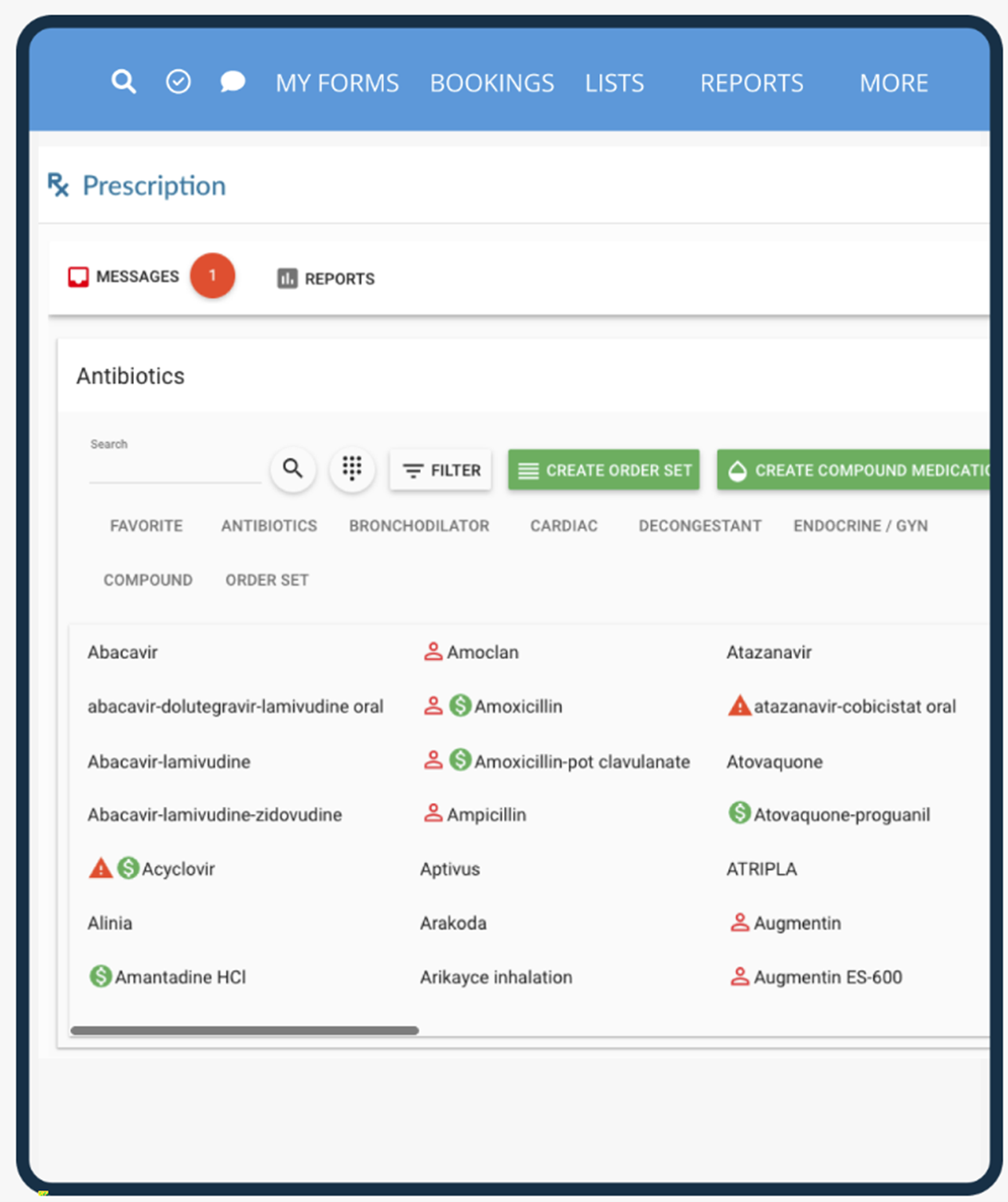Key Takeaways
- Switching to electronic prescriptions is more convenient, more accurate, and more efficient for both you and your patients.
- Avoid confusion and reduce the risk of medical errors with e-prescriptions.
- Features like refill reminders and prescription tracking improve patient adherence to treatment plans.
- With reduced admin workload and access to more affordable medication options, e-prescribing can save costs across the board.
- Access to a patient’s complete medication history helps you make better-informed treatment decisions.
- E-prescribing systems are safe, secure, and HIPAA-compliant.
- E-prescribing reduces paper use and helps save natural resources.
When the Medicare Modernization Act introduced e-prescribing in 2006, fewer than 7% of prescribers were e-prescribing, preferring traditional paper prescriptions. Since then, that number has exploded, and now over 90% of prescribers e-prescribe.
Research suggests that the e-prescribing market is expected to experience a 26.8% annual growth rate into 2030.
This boom is partly due to improved technology and trends, but there are far more reasons to switch to e-prescriptions. We narrowed them down to eight key benefits that highlight the advantages of e-prescribing for your practice, your patients, and the environment.
1. Enhanced Patient Safety
One of the most important benefits of e-prescribing is the reduced risk of errors. Traditional paper prescriptions can be plagued with issues like illegible handwriting, which opens the door for mistakes and misinterpretations.
A chicken-scratched prescription outlining crucial information like medication type, dosage, and frequency can interfere with supporting the patient’s care plan and medication safety.
With e-prescribing, everything is digitized, eliminating the possibility of misinterpretation. This helps make sure that patients receive the correct medication at the correct dosage every time.
In addition to accuracy, advanced e-prescribing systems include built-in safety checks like alerts for potential drug interactions or duplication.
Studies show that e-prescribing drastically reduces the risk of adverse drug events.
E-prescribing software provides an additional layer of protection, helping healthcare providers make safer prescribing decisions.
2. Increased Efficiency
Time is always at a premium in a healthcare setting, and e-prescribing can help you find more freedom in your day. Traditionally, paper prescriptions include manual steps like writing, faxing, or phoning in orders — processes that are not only time-consuming but also prone to delays and errors.
E-prescribing automates these tasks so you can send prescriptions directly to the pharmacy with just a few clicks.
Healthcare providers can spend less time on administrative tasks and more time on patient care, while pharmacies receive prescriptions faster and can prepare medications more quickly.
With increased accuracy, better efficiency, faster processing, and smoother workflow, e-prescribing benefits providers and patients alike.
3. Better Medication Adherence
Medication non-adherence can lead to worsened health outcomes and higher costs. E-prescribing makes it easier for patients to manage their medications.
Electronic prescriptions allow patients to have a better understanding of their treatment, including the type of medication, dosage, and refill schedule. This information helps patients stay on top of their medication schedules, reducing the likelihood of missed doses or forgotten prescriptions.
One study found that e-prescribing boosted patient adherence by 10 percent for new prescriptions.
4. Cost Savings
E-prescribing also offers real cost savings for both providers and patients. By reducing the administrative burden associated with managing paper prescriptions, healthcare providers can cut down on overhead costs.
Plus, fewer errors and more efficient workflows translate into less time spent on corrections and follow-ups. This translated to billions in health care savings in recent years.
For patients, e-prescribing can lead to lower medication costs. Many e-prescribing systems are integrated with pharmacy benefit managers or other cost-saving tools that can automatically suggest lower-cost alternatives, such as generic medications or preferred pharmacy networks.
Patients can often get the medications they need at more affordable prices, without the hassle of price shopping.
5. Improved Access to Medication History
Doctors and pharmacists need access to a patient’s complete medication history to make informed clinical decisions. In the traditional paper-based system, this information might be scattered across multiple providers or pharmacies, making it difficult to gather a comprehensive view.
E-prescribing systems centralize this information, giving healthcare providers instant access to a patient’s full medication history.
Easier access allows providers to make better-informed decisions about treatment plans and identify patterns of medication use that may indicate issues like overuse or underuse of certain drugs.
One study found that e-prescribing can reduce prescription opioid overdose by an estimated 22%.
6. Regulatory Compliance
The Drug Enforcement Administration (DEA) permits e-prescribing controlled substances, making it easier to keep a watchful eye on medication use. E-prescribing systems are designed to help healthcare providers meet strict regulatory requirements and protect patients.
In addition to streamlining workflow and improving patient care, e-prescribing helps healthcare providers stay compliant with ever-evolving regulations. One of the most important areas of regulatory compliance in healthcare is controlling and monitoring prescription medications, especially controlled substances like opioids.
PracticeQ integrates with ScriptSure, a leading e-prescribing system, to enhance medication management and ensure compliance with regulatory standards. Through this integration, providers can access the BAMBOO PMP Gateway, which automatically retrieves a comprehensive 12-month report of a patient's opioid prescription history.
This report consolidates data from multiple states' Prescription Monitoring Programs (PMPs), giving healthcare providers a complete view of the patient's controlled substance use. The report is easily accessed within PracticeQ, ensuring that providers have the most up-to-date information without the need for manual report generation.
In addition to controlled substance monitoring, quality e-prescribing systems are built to be HIPAA-compliant, ensuring that all prescription data is securely transmitted and stored. This protects sensitive patient information and helps practices avoid costly fines and penalties associated with non-compliance.
Together, PracticeQ and ScriptSure offer healthcare providers a seamless way to deliver safe, effective care while meeting all regulatory requirements with ease.
7. Patient Convenience
For patients, electronic prescribing systems take away stress and confusion. No longer do they need to worry about losing a paper prescription or making an extra trip to the doctor’s office for a refill.
With e-prescribing, prescriptions are sent directly to the pharmacy, and patients can usually request refills online, saving time and reducing hassle.
But convenience goes beyond just ease of use. E-prescribing also contributes to better health outcomes by ensuring that patients can get their medications quickly, without unnecessary delays.
More than 80 percent of patients prefer e-prescriptions — including older adults who are accustomed to paper prescriptions.
8. Environmental Benefits
In addition to all the patient and provider benefits, e-prescribing supports environmental sustainability. Traditional paper prescriptions contribute to significant paper waste, not to mention the environmental impact of printing, handling, storing, and disposing of all these documents.
The healthcare industry generates about 2 billion pounds of paper waste each year, so the waste associated with traditional prescriptions can pile up.
E-prescribing eliminates the need for paper prescriptions entirely, saving millions of sheets of paper each year.
The reduction in paper use contributes to conservation efforts and supports broader sustainability goals and keeping our planet green.
How PracticeQ Enhances e-Prescribing Efficiency

If you dream of a paperless practice — whether you want to minimize your carbon footprint or your workload — e-prescribing is a great way to start. The user-friendly interface of PracticeQ ensures that even those new to e-prescribing can quickly adapt, minimizing the learning curve and maximizing efficiency.
Integration with Practice Management
PracticeQ’s e-prescribing feature seamlessly integrates with other practice management tools, enhancing your practice’s overall efficiency.
User-Friendly Interface
Designed with ease of use in mind, PracticeQ’s e-prescribing feature simplifies prescription management. Even if you’re familiar with a pen-and-paper practice, PracticeQ’s user friendly features will make the transition a breeze.
Always Stay Compliant
With its secure, HIPAA-compliant infrastructure, PracticeQ safeguards patient data and supports compliance with all relevant healthcare regulations.
Schedule a demo today or start your free trial to see how PracticeQ can transform your practice’s e-prescribing processes.
A Decade of Data Examined: The Evolution of Electronic Prescribing. (2024, July 15). Health IT Buzz. https://www.healthit.gov/buzz-blog/health-data/a-decade-of-data-examined-the-evolution-of-electronic-prescribing
Ammenwerth, E., et al. (2008). The Effect of Electronic Prescribing on Medication Errors and Adverse Drug Events: A Systematic Review. Journal of the American Medical Informatics Association, 15(5), 585–600. https://doi.org/10.1197/jamia.m2667
E-Prescribing Market Size & Share Analysis Report, 2030. (n.d.). Www.grandviewresearch.com. https://www.grandviewresearch.com/industry-analysis/e-prescribing-market
HERC -- Paper Recycling. (n.d.). https://www.hercenter.org/wastereduction/paper.php
Porterfield, A., Engelbert, K., & Coustasse, A. (2014). Electronic prescribing: improving the efficiency and accuracy of prescribing in the ambulatory care setting. Perspectives in Health Information Management, 11(Spring), 1g. https://www.ncbi.nlm.nih.gov/pmc/articles/PMC3995494/
Schleiden, L. J., Odukoya, O. K., & Chui, M. A. (2015). Older Adults’ Perceptions of E-Prescribing: Impact on Patient Care. Perspectives in Health Information Management, 12(Winter), 1d. https://www.ncbi.nlm.nih.gov/pmc/articles/PMC4700869/
Study: E-Prescribing Shown to Improve Outcomes and Save Healthcare System Billions of Dollars | Surescripts. (n.d.). Surescripts.com. https://surescripts.com/news-center/press-releases/detail/212_eprescribing


